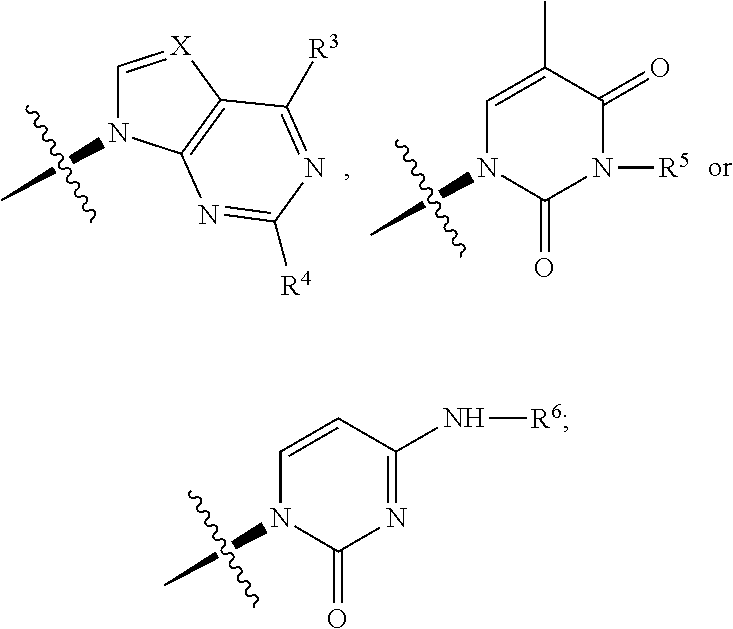Carbocyclic nucleoside reverse transcriptase inhibitors
a carbocyclic nucleoside and reverse transcriptase technology, applied in heterocyclic compound active ingredients, group 5/15 element organic compounds, organic chemistry, etc., can solve the problems of mutant hiv strains that are resistant to known inhibitors, and are highly susceptible to debilitating and ultimately fatal opportunistic infections
- Summary
- Abstract
- Description
- Claims
- Application Information
AI Technical Summary
Benefits of technology
Problems solved by technology
Method used
Image
Examples
example 13
[0114]
Preparation of Compound (+ / −) 12: (1S,2S,4R)-4-(6-chloro-2-fluoro-9H-purin-9-yl)-2-ethynyl-2-(hydroxymethyl)cyclopentan-1-ol and (1R,2R,4S)-4-(6-chloro-2-fluoro-9H-purin-9-yl)-2-ethynyl-2-(hydroxymethyl)cyclopentan-1-ol
[0115]Step 1:
[0116]To a suspension of triphenylphosphine (474 mg, 1.81 mmol) in THF (10 mL) under nitrogen at 0° C. was added diisopropyl azodicarboxylate (0.33 mL, 1.69 mmol). This reaction mixture was stirred at 0° C. for 30 min. To a solution of Compound (+ / −) 7 (264 mg, 0.60 mmol) and 6-chloro-2-fluoropurine (156 mg, 0.90 mmol) in THF (10 mL) at −41° C. was added the previous solution. The reaction mixture was stirred at −41° C. for 2 h and at rt overnight, and then, concentrated under reduced pressure. The crude residue was purified by column chromatography on silica gel (DCM / MeOH: 0 to 10%) to afford the expected compound (+ / −) 10. 1H NMR (DMSO-d6, 400 MHz) δ (ppm) 8.78 (s, 1H), 7.66-7.59 (m, 4H), 7.48-7.38 (m, 6H), 5.34-5.25 (m, 1H), 4.66 (d, J=6.70 Hz, 1...
example 18
[0125]
Preparation of Compound (+ / −) 17: (1S,2S,4R)-4-(2,6-dichloro-9H-purin-9-yl)-2-ethynyl-2-(hydroxymethyl)cyclopentan-1-ol and (1R,2R,4S)-4-(2,6-dichloro-9H-purin-9-yl)-2-ethynyl-2-(hydroxymethyl)cyclopentan-1-ol
[0126]Compound (+ / −) 17 was synthesized according to a similar procedure to that described for the synthesis of compound (+ / −) 12, starting for step 1 from compound (+ / −) 7 and 2,6-dichloro-9H-purine.
[0127]Step 1:
[0128]Compound (+ / −) 15: 1H NMR (DMSO-d6, 400 MHz) δ (ppm) 8.83 (s, 1H), 7.66-7.60 (m, 4H), 7.50-7.38 (m, 6H), 5.34-5.26 (m, 1H), 4.68-4.64 (m, 2H), 4.56 (t, J=7.32 Hz, 1H), 3.77 (d, J=9.95 Hz, 1H), 3.73 (d, J=9.95 Hz, 1H), 3.25 (s, 3H), 3.23 (s, 1H), 2.61-2.53 (m, 2H), 2.47-2.32 (m, 2H), 1.02 (s, 9H); MS (ESI) m / z=609.5 (MH+).
[0129]Step 2:
[0130]Compound (+ / −) 16: 1H NMR (DMSO-d6, 400 MHz) δ (ppm) 8.86 (s, 1H), 5.29-5.20 (m, 2H), 4.69 (d, J=6.67 Hz, 1H), 4.65 (d, J=6.67 Hz, 1H), 4.36 (t, J=7.09 Hz, 1H), 3.60-3.53 (m, 2H), 3.30 (s, 3H), 3.14 (s, 1H), 2.48-2.44 (m,...
example 22
[0136]
Preparation of Compound (+ / −) 21: (1S,2S,4R)-4-(2,4-dichloro-7H-pyrrolo[2,3-d]pyrimidin-7-yl)-2-ethynyl-2-(hydroxymethyl)cyclopentan-1-ol and (1R,2R,4S)-4-(2,4-dichloro-7H-pyrrolo[2,3-d]pyrimidin-7-yl)-2-ethynyl-2-(hydroxmethyl)cyclopentan-1-ol
[0137]Compound (+ / −) 21 was synthesized according to a similar procedure to that described for the synthesis of compound (+ / −) 12, beginning with compound (+ / −) 7 and 2,4-dichloro-7H-pyrrolo[2,3-d]pyrimidine.
[0138]Step 1:
[0139]Compound (+ / −) 19: 1H NMR (DMSO-d6, 400 MHz) δ (ppm) 7.91 (d, J=3.70 Hz, 1H), 7.66-7.61 (m, 4H), 7.50-7.39 (m, 6H), 6.76 (d, J=3.70 Hz, 1H), 5.42-5.34 (m, 1H), 4.69-4.64 (m, 2H), 4.51 (t, J=7.23 Hz, 1H), 3.78 (d, J=9.94 Hz, 1H), 3.74 (d, J=9.94 Hz, 1H), 3.24 (s, 3H), 3.22 (s, 1H), 2.48-2.23 (m, 4H), 1.02 (s, 9H); MS (ESI) m / z=630.5 (MNa+).
[0140]Step 2:
[0141]Compound (+ / −) 20: 1H NMR (DMSO-d6, 400 MHz) δ (ppm) 7.94 (d, J=3.75 Hz, 1H), 6.76 (d, J=3.75 Hz, 1H), 5.44-5.35 (m, 1H), 5.24 (brs, 1H), 4.69 (d, J=6.61 Hz, 1H...
PUM
 Login to View More
Login to View More Abstract
Description
Claims
Application Information
 Login to View More
Login to View More - R&D
- Intellectual Property
- Life Sciences
- Materials
- Tech Scout
- Unparalleled Data Quality
- Higher Quality Content
- 60% Fewer Hallucinations
Browse by: Latest US Patents, China's latest patents, Technical Efficacy Thesaurus, Application Domain, Technology Topic, Popular Technical Reports.
© 2025 PatSnap. All rights reserved.Legal|Privacy policy|Modern Slavery Act Transparency Statement|Sitemap|About US| Contact US: help@patsnap.com



